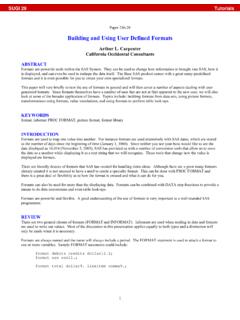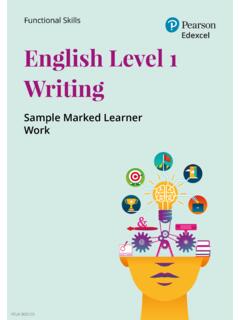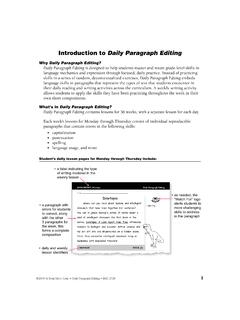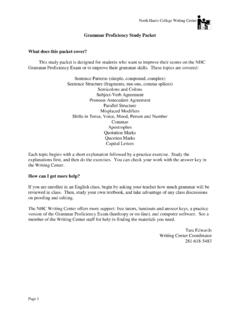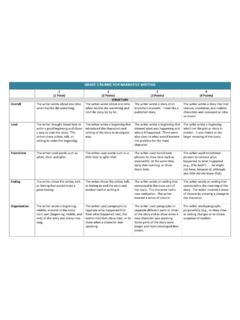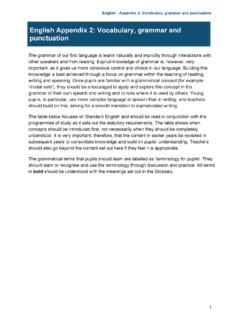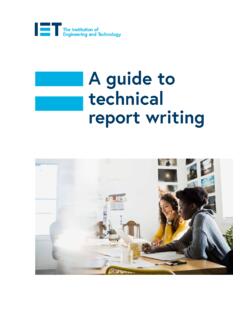Transcription of Guide to referencing using the Harvard system
1 Guide to referencing using the Harvard system The University of Bradford retains copyright for this material, which may not be reproduced without prior written permission. If you need to view this document in an alternative format or have any comments on the content email: Contents Introduction ..1. Why do I have to reference? .. 1. What do and don't I have to reference? .. 1. How is this referencing Guide organised? .. 2. Basic points of the Harvard style .. 2. How to find the information to write a reference .. 2. For books .. 3. For journal articles .. 3. For electronic resources .. 3. For all sources .. 3. If I read a book that draws from another author's work and I want to use that information, how do I cite and reference it? .. 4. If I read a book that is not in English, how do I cite and reference it? .. 4. Help is available from .. 4. EndNote .. 5. Part 1: Citing within the text of written work.
2 5. Practical points ..6. Do I include page numbers in the citation? .. 6. Multiple authors .. 7. et al.. 8. Unknown 8. Corporate authors (organisations) .. 9. Unknown date .. 10. Citing things you yourself created .. 10. Your own photographs or other images .. 10. Your own research or other unpublished work of yours .. 10. Citing multiple works by the same author from the same year .. 10. Citing more than one source in the same sentence .. 11. Citing secondary sources .. 12. Guide to referencing using the Harvard system Part 2: The reference 13. In 13. referencing electronic sources .. 14. I need to reference something that isn't in this document .. 15. Rules and examples of correct references .. 16. Books .. 16. Electronic books .. 17. Chapters in books .. 18. Journal articles .. 20. Electronic journal articles .. 21. Sections of journal 23. Webpages and web documents .. 24. Online data, databases and statistics.
3 25. Other types of source (in alphabetical order) .. 26. Audio and video sources .. 26. Online video .. 26. Films .. 27. Episodes of a television programme .. 28. A particular section within a television programme .. 29. Special features of a film or TV programme on a DVD or 31. Episodes of a radio programme .. 32. A particular section within a radio programme .. 33. Podcasts or other online audio files .. 34. Book series .. 35. Chapters in book series .. 36. Comics, books of cartoons, manga, graphic novels .. 37. E-comics, webcomics and online cartoons .. 39. Conferences .. 39. Full books of conference proceedings .. 40. Electronic sources apart from ordinary web 41. Tweets .. 41. Guide to referencing using the Harvard system Blog posts .. 42. Wikis .. 43. Cochrane Database of Systematic Reviews .. 44. Computer games .. 44. Mobile apps .. 45. Historical works .. 46. Sources with an author.
4 47. Sources with no author .. 48. Images (tables, photographs, illustrations etc.) .. 49. Online images .. 50. Lectures and personal communications .. 51. Lectures, presentations, study guides or handouts .. 51. Personal communications (conversations, emails, interviews, etc) .. 52. Legal and official publications .. 53. Government and parliamentary publications (official publications) .. 53. Documents produced by government departments .. 53. Parliamentary publications: Command Papers .. 54. Hansard 55. Laws and other legal documents .. 56. Acts of Parliament (statutes) .. 57. Statutory instruments .. 58. Cases from Law Reports .. 58. Maps .. 59. Online maps .. 60. Newspaper articles .. 61. Online newspaper 62. NICE guidelines .. 63. Non-English and translated sources .. 64. Translated works .. 64. Works read in a language that is not English .. 65. Patents .. 65. Guide to referencing using the Harvard system Reports and organisational policies.
5 66. Sacred texts .. 67. Secondary references .. 68. Standards .. 70. Theses, dissertations or unpublished research .. 70. Unpublished archive materials .. 72. EndNote .. 72. Manually editing EndNote citations or references .. 72. Edit the EndNote record itself .. 72. Edit citations or references in your Word document .. 73. The Reference List and Bibliography .. 74. Sample Reference List/Bibliography .. 74. Guide to referencing using the Harvard system September 2019. Introduction Why do I have to reference? When you refer to another piece of work you must always acknowledge the source of that information. This is To avoid plagiarism. To give appropriate credit to the person who did the work you are using . To enable a reader to trace your sources and follow up your work. To enable a reader to distinguish your ideas from someone else's and show the range of your reading. To demonstrate the evidence supporting your arguments; this supports your ideas and theories and adds credibility.
6 The rules for how to reference are all there to support these principles, and to make sure that your references are clear and consistent so that it is easy for someone reading your work to follow them. It is more important to get the spirit of giving credit for other people's work right than to make sure all your commas are in the right places. What do and don't I have to reference? You reference all the information you take in from your reading and use to build your work, whether you quote it exactly or put your understanding of it in your own words (paraphrase it). You don't have to reference: Data that you get from your own experiments- provided this is the first time you are presenting them. Your own ideas and conclusions. Facts that are generally known and undisputed. Some students are nervous that they might come up with similar ideas to someone without knowing it. You could do a search to find out if anybody has published something like your idea, reference their work, and then discuss how your idea is different from theirs.
7 Students can also worry about which facts are generally known ; you should be able to search and easily 1. Guide to referencing using the Harvard system find several people talking about the well-known fact, so you can reference them to show that it is commonly talked about. How is this referencing Guide organised? Part 1 covers how to create the citations that go in the body of your work to show where all the information you use has come from. Part 2 covers rules and examples of how to reference many different kinds of information sources. It starts with the items that you are most likely to reference often (books, journal articles and webpages) and then goes on to items that are slightly less commonly used, listed alphabetically by the main heading. Then there is information on using EndNote, and finally an example of what a reference list should look like. Basic points of the Harvard style There are two parts to referencing using the Harvard system : 1.
8 Citing in the text of your work- this means acknowledging, within your text, the sources that you have used. 2. The Reference List - this is the list of sources you have used. It is one list in alphabetical order (A-Z order). You will write it at the end of your work. It is not counted in the word count for your assignment. References are detailed descriptions of the sources from which you acquired your information. A key piece of information is the name of the person who created your source of information. This could be the person who wrote a book or article, the person who took a photograph, the person who drew a graph, etc. The most common things you should be using are written sources, so we will use the label author (writer) to stand for any creator. There can also be corporate authors- institutions such as companies, charities, government departments, etc. How to find the information to write a reference It can often be difficult to locate the pieces of information you need for your reference, especially for electronic resources.
9 Try the following sources: 2. Guide to referencing using the Harvard system September 2019. For books If you have the book to hand, use the title page and copyright statement to find the author and publication details, plus the contents page for book chapters. Alternatively, the library catalogue gives you all the information you need to reference a book. If the book is not on our catalogue, try Library Hub Discover the combined catalogue of the biggest research libraries in the UK. For journal articles All the information you need should be at the top of the first page of the article, or sometimes at the foot of the first page. Sometimes information such as issue numbers is omitted from PDF versions of articles. In that case you should look at the HTML version or the search page of the database in which you found the article. For electronic resources If you can't find a publication date, you can use the last updated' date at the foot of the page.
10 Look at the web address in the bar at the top of your browser this will often give you the publishing organisation. For example, is the University of Bradford's homepage. If you can't tell much about the website from the page you are on, visit their home page or About Us page to find out who they are. If you can't find a title, use the heading of the browser window. For all sources Type the details you have into Google. Someone will usually have referenced the source before you! Bear in mind you will have to change the referencing style, but this should help you find the relevant information. 3. Guide to referencing using the Harvard system If I read a book that draws from another author's work and I want to use that information, how do I cite and reference it? Pears and Shields (2010: 8) explain this as In some cases you will read a source that refers to the work of someone else, known as a secondary source.

